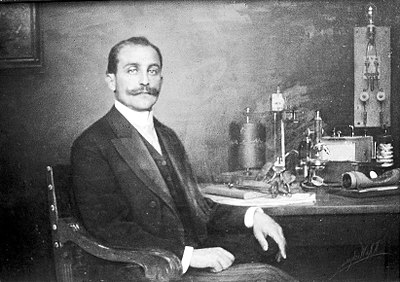Stefan Jellinek
Stefan Jellinek (born May 29, 1871 in Prerau (Moravia) , † September 2, 1968 in Edinburgh , Scotland) was an Austro-British doctor who had to emigrate in 1938.
Electric apparent death theory
His main field of work was in the context of commercial medicine , as occupational medicine was called back then, electrical accidents . In 1899 he began electropathological studies. He also examined people who were struck by lightning . So he published his theory of electrical apparent death . Contrary to popular belief at the time, resuscitation can help people after an electrical accident. His tenet was: in the event of an electrical accident, try to resuscitate until death spots appear, only then can you give up.
Breakthrough in Kaisersteinbruch
The ultimate breakthrough came with a sensational event. In August 1924, a 30-year-old woman was lying with her young daughter in Kaisersteinbruch , a small town on the Lower Austria - Burgenland border, in the mortuary chamber next to the church . Both were killed by lightning in a thunderstorm an hour ago. Then came a Viennese vacationer and colonel doctor named Dr. Warecha over. Certainly the two were dead, he said too. Still, one could try Professor Jellinek's theorem. So the doctor started artificial breathing for the woman and explained to a farmer what to do with the child. After an hour of struggle, they both woke up. The incident caused a tremendous stir and made the Jellinek method known worldwide.
Electropathological Museum
From 1909 he was also in charge of the electropathological museum he founded. In this he collected preparations from accidents in order to advance research on accident prevention and the healing of the consequences of such accidents.
The University of Vienna set up its own chair for electropathology, the first in the world. In 1936 the museum was also transferred to the university.
After he had to leave Austria as a Jew for racist reasons in 1939 , he emigrated to Great Britain and taught at Queen's College in Oxford . After the Second World War , his collection was returned to him without a restitution process . He himself stayed in Great Britain, but came to Vienna several times a year, where he continued to look after his museum. But he also held lectures at the Technical University of Vienna well into old age. He died in Edinburgh in 1968.
After the museum closed in 2002, his collection came into the possession of the Technical Museum in Vienna. Parts are to be regarded as a special exhibition, other parts of the collection are housed in the Narrenturm of the old General Hospital , which reopened in February 2010.
Works
- Electropathology. Illnesses caused by lightning strikes and high electric current in clinical and forensic presentation . Enke publishing house, 1903
- Electrical protection in 132 pictures . With pictures by Franz Danilowatz, Franz Roubal and others Deutscher Verlag für Jugend und Volk, Vienna and Leipzig 1931
Appreciation
- In 1997, Gottfried Biegelmeier donated a joint medal of honor to him and the German Conrad Alvensleben , who also made a contribution to the safety of electricity applications: the Alvensleben-Jellinek Medal of Honor , which is awarded to people who also deal with the topic.
- In 1961 he was one of the winners of the Karl Renner Prize .
literature
- Hans Bankl : The knife is in the back, history of forensic medicine. Kremayr and Scheriau, Vienna 2001.
- Gottfried Biegelmeier , Heinrich Freiberger : Alvensleben and Jellinek. A dialogue on the way to understanding the causes of death from electricity. In: Electrical engineering and mechanical engineering . 96. Jg. (1979), H. 2, pp. 80-88.
- Helmuth Furch : Historical Lexicon Kaisersteinbruch, sensational event 1924 . Museum and Culture Association, Kaisersteinbruch 2002–2004, pp. 700 f. ISBN 978-3-9504555-8-8 .
- Ernst Jellinek: Jellinek, Stefan. In: New German Biography (NDB). Volume 10, Duncker & Humblot, Berlin 1974, ISBN 3-428-00191-5 , p. 396 f. ( Digitized version ).
- Stefan Jellinek . In: Judith Bauer-Merinsky: The effects of the annexation of Austria by the German Reich on the medical faculty of the University of Vienna in 1938: biographies of dismissed professors and lecturers . Dissertation, Vienna 1980, pp. 109–111.
- Jellinek, Stefan , in: Werner Röder; Herbert A. Strauss (Ed.): International Biographical Dictionary of Central European Emigrés 1933-1945 . Volume 2.1. Munich: Saur, 1983 ISBN 3-598-10089-2 , p. 568
Individual evidence
- ^ Poster of the Electropathological Museum, accessed around 1930 on the website of the Technisches Museum Wien on December 4, 2011
- ↑ DNB 580993329 ; Images from the work ( Memento of the original from September 4, 2012 in the Internet Archive ) Info: The archive link has been inserted automatically and has not yet been checked. Please check the original and archive link according to the instructions and then remove this notice.
Web links
- Literature by and about Stefan Jellinek in the catalog of the German National Library
- Stefan Jellinek (1897–1969): Displaced 1938 (54) In: Van Swieten blog of May 23, 2008
- Jellinek's Electropathological Museum
| personal data | |
|---|---|
| SURNAME | Jellinek, Stefan |
| BRIEF DESCRIPTION | Austrian medic |
| DATE OF BIRTH | May 29, 1871 |
| PLACE OF BIRTH | Prerau (Moravia) |
| DATE OF DEATH | 2nd September 1968 |
| Place of death | Edinburgh |
